3 simple tips for inclusive meetings

Inclusion is a big topic in corporate life these days.
We hear grand statements about diversity and inclusion but how included do you feel in the meetings you attend?
Do you turn up as told, get talked at for two hours, then leave feeling frustrated, not having had the chance to say your piece? Or do you chair meetings and find it difficult to include everyone, particularly the quiet ones?
Here are three simple tips for inclusive meetings, and if you’re a mere attendee and want to become a participant, you could find a way of getting the chairperson to read this blog post.
You haven’t arrived until your voice is in the room
There was a saying among North American indigenous peoples: “You haven’t arrived until your voice is in the room”. I think this is great, but I’d like to update it for our times: “You are not included until your voice is in the room and heard.”
It’s easy to get everyone’s voice in the room and heard. And it makes a big difference in terms of energy and morale.
Right at the start, as chairperson, state the purpose of the meeting and then go around the room giving everyone a chance to say something while all others listen. No need for taking notes, just listen.
It could be an invitation to introduce themselves if people don’t know each other. It could be “What’s going well for you?” or one of my favorites “What are you reading or listening to or watching?” I think this is about human beings doing the humane bit, rather than just diving into the detail or the problem, as is so often done.
If the whole of your meeting is taken up by this then you have too many people in the meeting. Or maybe you haven’t done something like this before and each person has so much to say in this rare opportunity to say it that they take all the time they can, while they can.
Try often with few people and this will become a great way to spend the first five minutes of your meetings.
What’s your biggest concern for today’s meeting?
It’s great giving your people the chance to get their voice in the room and be heard by asking them “what’s going well” but what if they have a big concern?
If people are concerned about something – and they usually are at the start of a meeting, otherwise they likely wouldn’t be there – and they don’t get the opportunity to voice it then they will withhold at best or may become disruptive or worse as time goes by.
But the trouble is, without deep psychological safety being present, many people are reluctant to share their true concern at the start of a meeting. Here’s what to do:
Ask people to complete the following sentence on a sheet of paper: “My biggest concern for today’s meeting is …”
Tell them you won’t ask people to share what they wrote.
You complete the sentence on your own sheet of paper.
When everyone has finished, crumple up your sheet and say, “But I didn’t say someone else wouldn’t share your concern,” and chuck your ball of paper to a random place in the room, instructing everyone to follow suit.
There is usually surprise and laughter as paper flies around. Then ask everyone to pick up and read out someone else’s anonymous concern. And there you are, all the concerns are out.
Now you are ready to get down to business.
Speak 1/Nth of the time, where N is the number of people in the room
The participants have got their voice in the room, feel listened to and have put their big concern on the table for all to see.
The challenge now is to ensure equal air time. Some may not want it but they are there for a reason, they have a contribution to make, so part of your role is to encourage it and them.
Others may unwittingly hog too much air time, and others may set out to dominate proceedings.
Letting everyone know in advance that you want equal time for everyone to speak and contribute sets the tone. Limiting talking time for some and encouraging others to elaborate on their carefully chosen few words will ensure all participants get equal opportunity to shape the meeting outcome.
A brilliant build on this is to sit in a circle (knees almost touching) with no table. Give the first person to speak a ball of wool asking them to hold the end and pass the ball to the next person talking. They hold the line of wool and pass the ball of wool to the next person and so on for the whole conversation.
Observe the web of the conversation as it develops, see who isn’t holding any wool (have not said anything) and who is holding the most (have talked the most). Ask people to observe the web of wool in front of them and what they make of it.
This is an illuminating and very popular exercise once people are over the shock of not having a table in front of them and the first few awkward passes of the wool between them in the circle.
Enough of the platitudes, thanks.
The grand statements companies make about how inclusive they are often ring hollow.
Think of annual roadshows and main board presentations. There are 200 people in the room, with executives on the stage working through a 60-slide PowerPoint presentation.
“Any Questions?” they ask after they finally finish. “No? Great! Food is served next door.”
Or worse, the event is held at HQ, videoed and sent out to the regions where they assemble to watch it.
That’s not inclusion, it’s something else.
You can build inclusion one meeting at a time using these three simple and practical tips. Enough of the platitudes, thanks!
